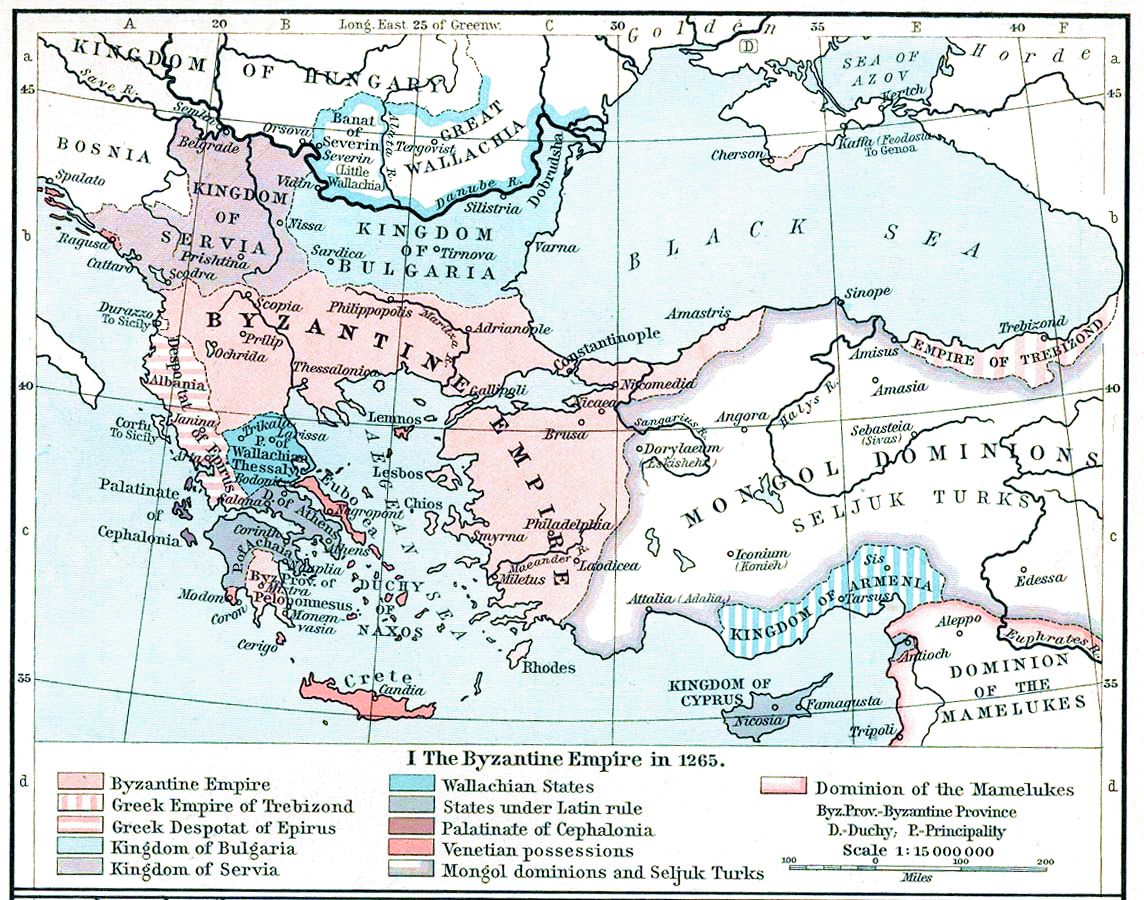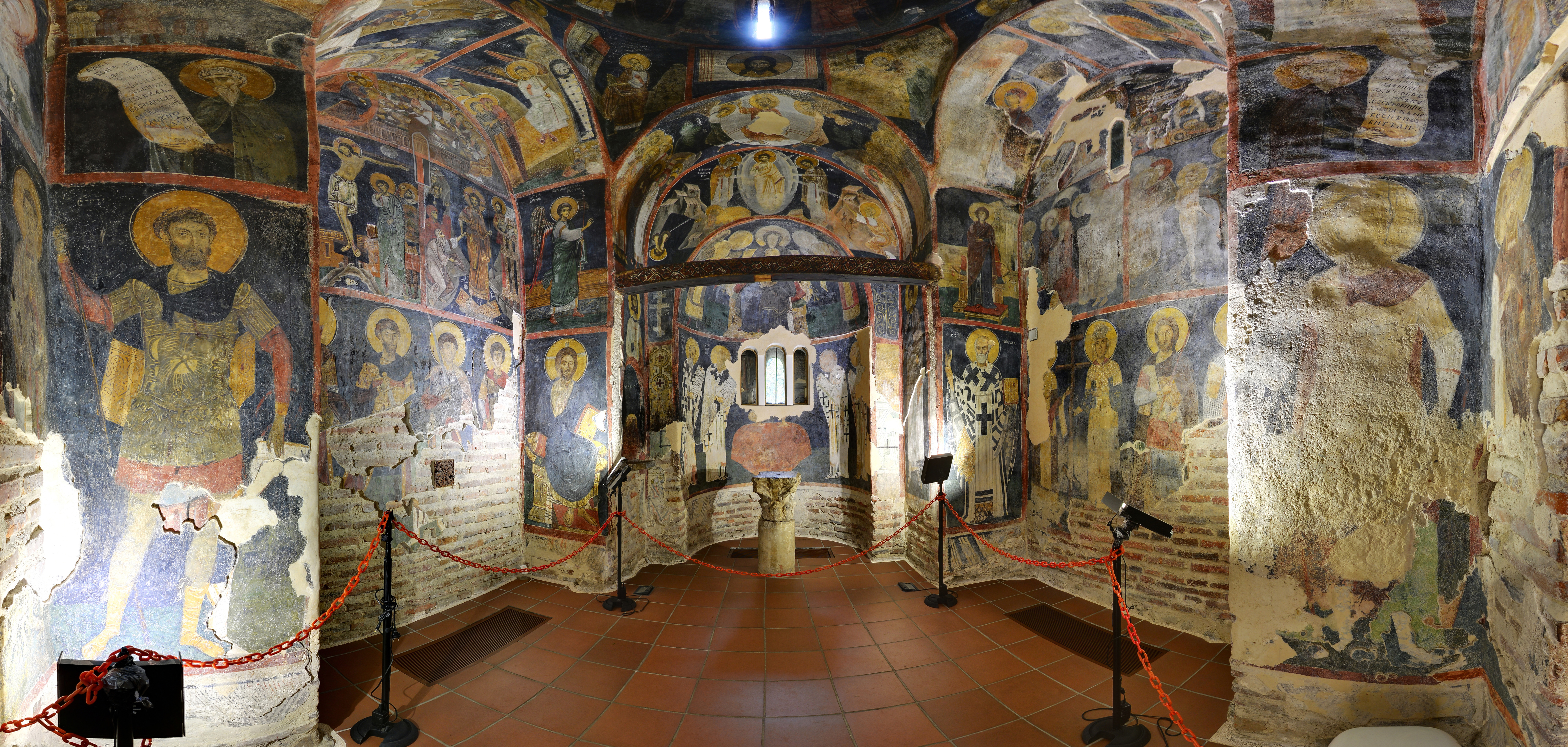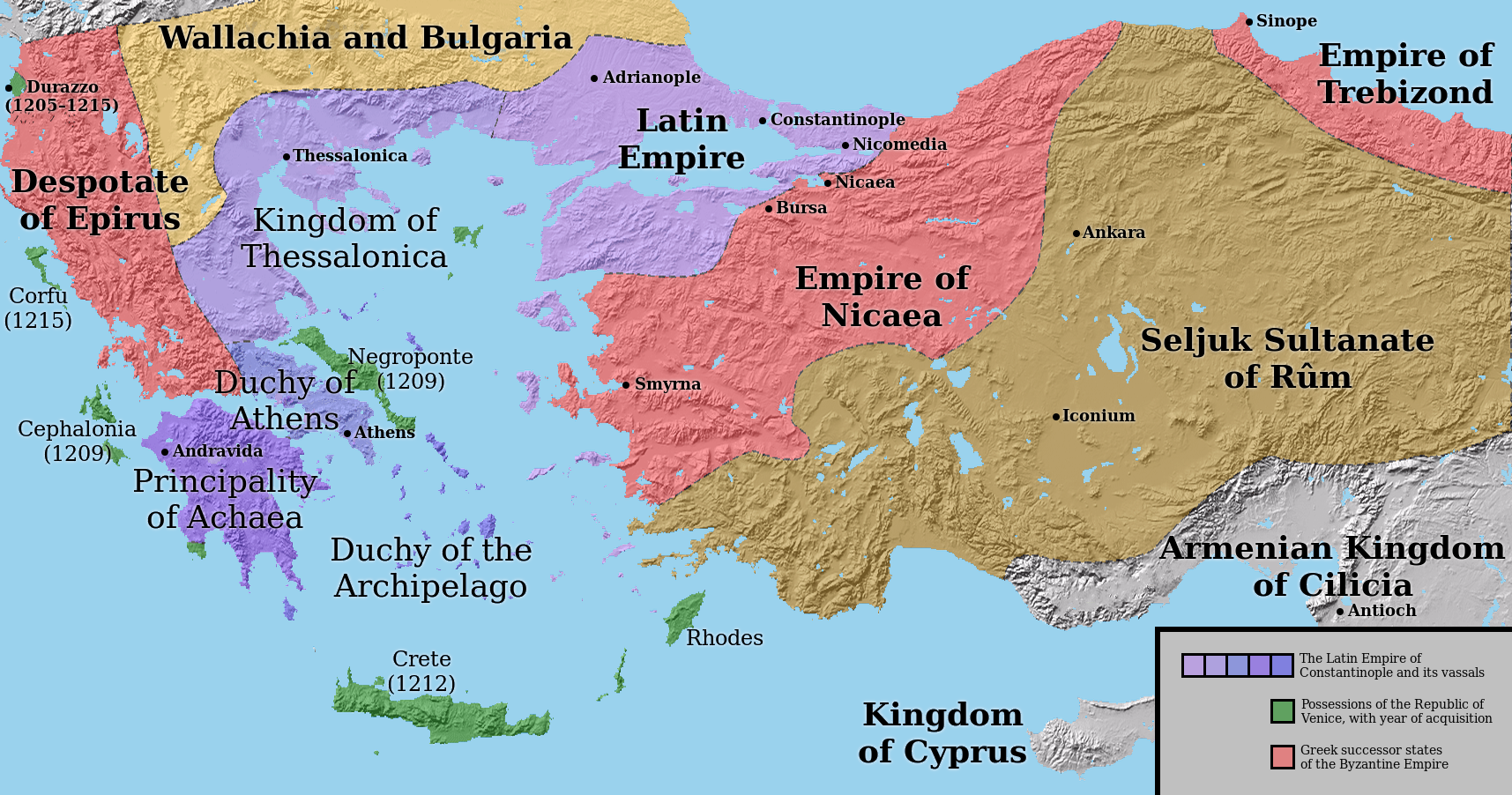|
1259
Year 1259 ( MCCLIX) was a common year starting on Wednesday of the Julian calendar. Events By place Europe * September – Battle of Pelagonia: The Empire of Nicaea defeats the Principality of Achaea, ensuring the eventual reconquest of Constantinople in 1261. * December 4 – Kings Louis IX of France and Henry III of England agree to the Treaty of Paris, in which Henry renounces his claims to French-controlled territory on continental Europe (including Normandy), in exchange for Louis withdrawing his support for English rebels. * The famous frescoes of the Boyana Church in Bulgaria are completed (the church and its murals are now a UNESCO World Heritage Site). * The German cities of Lübeck, Wismar, and Rostock enter into a pact to defend against pirates of the Baltic Sea, laying the groundwork for the Hanseatic League. * Nogai Khan leads the second Mongol Golden Horde attack against Lithuania, and Poland. * Epirote–Nicaean conflict. Asia * August 11 – ... [...More Info...] [...Related Items...] OR: [Wikipedia] [Google] [Baidu] |
Battle Of Pelagonia
The Battle of Pelagonia or Battle of Kastoriae.g. ; . took place in early summer or autumn 1259, between the Empire of Nicaea and an anti-Nicaean alliance comprising Despotate of Epirus, Kingdom of Sicily and the Principality of Achaea. It was a decisive event in the history of the Eastern Mediterranean, ensuring the eventual reconquest of Constantinople and the end of the Latin Empire in 1261. The rising power of Nicaea in the southern Balkans, and the ambitions of its ruler, Michael VIII Palaiologos, to recover Constantinople, led the formation of a coalition between the Epirote Greeks, under Michael II Komnenos Doukas, and the chief Latin rulers of the time, the Prince of Achaea, William of Villehardouin, and Manfred of Sicily. The details of the battle, including its precise date and location, are disputed as the primary sources give contradictory information; modern scholars usually place it either in July or in September, somewhere in the plain of Pelagonia or near Kasto ... [...More Info...] [...Related Items...] OR: [Wikipedia] [Google] [Baidu] |
Treaty Of Paris (1259)
The Treaty of Paris (1259) was a peace agreement between England and France that concluded decades of territorial conflict. It followed a long history of tensions dating back to the Norman Conquest and intensified by King John’s loss of Normandy in 1204 and his successors’ failed attempts to recover those lands. Pressured by military defeats, internal unrest, and King Louis IX’s desire for continental stability before the launch of the Seventh Crusade, both kingdoms entered negotiations. The treaty marked a significant turning point but left several issues unresolved, setting the stage for future disputes. Background This era held monumental significance in certain regions, particularly in Paris, which was considered “scarcely inferior to Rome” and recognized as one of the most important cities in Europe. Paris’ role as the seat of Europe’s oldest university, established to study God’s dealings with mankind, reinforced its cultures and intellectual importance. Th ... [...More Info...] [...Related Items...] OR: [Wikipedia] [Google] [Baidu] |
Second Mongol Invasion Of Poland
The Second Mongol invasion of Poland was carried out by General Boroldai (Burundai) of the Golden Horde in 1259–1260. During this invasion the cities of Sandomierz, Kraków, Lublin, Zawichost, and Bytom were sacked by the Mongols for the second time. History The invasion began in late 1259, after a powerful Mongol army had been sent to the Kingdom of Galicia–Volhynia in order to punish King Daniel of Galicia for his independent actions. King Daniel had to comply to Mongol demands, and in 1258, his forces joined the Mongols in the raid on the Grand Duchy of Lithuania. To weaken Daniel's position, the Golden Horde decided to attack his allies, Hungarian King Béla IV, and Duke of Kraków, Bolesław V the Chaste. The purpose of the invasion was to loot the divided Kingdom of Poland (see Testament of Bolesław III Krzywousty), and to weaken Duke of Kraków Bolesław V the Chaste, whose province, Lesser Poland, began a process of fast development. According to the Mongol ... [...More Info...] [...Related Items...] OR: [Wikipedia] [Google] [Baidu] |
Golden Horde
The Golden Horde, self-designated as ''Ulug Ulus'' ( in Turkic) was originally a Mongols, Mongol and later Turkicized khanate established in the 13th century and originating as the northwestern sector of the Mongol Empire. With the division of the Mongol Empire after 1259, it became a functionally separate khanate. It is also known as the Kipchak Khanate or the Ulus of Jochi, and replaced the earlier, less organized Cuman–Kipchak confederation. After the death of Batu Khan (the founder of the Blue Horde) in 1255, his dynasty flourished for a full century, until 1359, though the intrigues of Nogai Khan, Nogai instigated a partial civil war in the late 1290s. The Horde's military power peaked during the reign of Özbeg Khan (1312–1341), who adopted Islam. The territory of the Golden Horde at its peak extended from Siberia and Central Asia to parts of Eastern Europe from the Ural Mountains, Urals to the Danube in the west, and from the Black Sea to the Caspian Sea in the south ... [...More Info...] [...Related Items...] OR: [Wikipedia] [Google] [Baidu] |
Mongol Empire
The Mongol Empire was the List of largest empires, largest contiguous empire in human history, history. Originating in present-day Mongolia in East Asia, the Mongol Empire at its height stretched from the Sea of Japan to parts of Eastern Europe, extending northward into parts of the Arctic; eastward and southward into parts of the Indian subcontinent, mounting invasions of Southeast Asia, and conquering the Iranian plateau; and reaching westward as far as the Levant and the Carpathian Mountains. The Mongol Empire emerged from the unification of several nomad, nomadic tribes in the Mongol heartland under the leadership of Temüjin, known by the title of Genghis Khan (–1227), whom a council proclaimed as the ruler of all Mongols in 1206. The empire grew rapidly under his rule and that of his descendants, who sent out Mongol invasions, invading armies in every direction. The vast transcontinental empire connected the Eastern world, East with the Western world, West, and the Pac ... [...More Info...] [...Related Items...] OR: [Wikipedia] [Google] [Baidu] |
Henry III Of England
Henry III (1 October 1207 – 16 November 1272), also known as Henry of Winchester, was King of England, Lord of Ireland, and Duke of Aquitaine from 1216 until his death in 1272. The son of John, King of England, King John and Isabella of Angoulême, Henry assumed the throne when he was only nine in the middle of the First Barons' War. Cardinal Guala Bicchieri declared the war against the rebel barons to be a religious crusade and Henry's forces, led by William Marshal, defeated the rebels at the battles of Battle of Lincoln (1217), Lincoln and Battle of Sandwich (1217), Sandwich in 1217. Henry promised to abide by the Magna Carta#Great Charter of 1225, Great Charter of 1225, a later version of the 1215 Magna Carta, which limited royal power and protected the rights of the major barons. Henry's early reign was dominated first by William Marshal, and after his death in 1219 by the magnate Hubert de Burgh. In 1230, the King attempted to reconquer the Angevin Empire, provinces of ... [...More Info...] [...Related Items...] OR: [Wikipedia] [Google] [Baidu] |
Boyana Church
The Boyana Church () is a medieval Bulgarian Orthodox church situated on the outskirts of Sofia, the capital of Bulgaria, in the Boyana quarter. In 1979, the building was added to the UNESCO World Heritage List. The east wing of the two-story church was originally constructed in the late 10th or early 11th century, then the central wing was added in the 13th century under the Second Bulgarian Empire, the whole building being finished with a further expansion to the west in the middle of the 19th century. A total of 89 scenes with 240 human images are depicted on the walls of the church. History and architecture The Boyana Church was built in three stages: in the late 10th to early 11th, the mid-13th, and the mid-19th centuries. The oldest section (the eastern church) is a small one-apse cross-vaulted church with inbuilt cruciform supports. It was built in the late 10th or the early 11th century. The second section, which adjoins the eastern church, was commissioned by Sebas ... [...More Info...] [...Related Items...] OR: [Wikipedia] [Google] [Baidu] |
Louis IX Of France
Louis IX (25 April 1214 – 25 August 1270), also known as Saint Louis, was King of France from 1226 until his death in 1270. He is widely recognized as the most distinguished of the Direct Capetians. Following the death of his father, Louis VIII, he was Coronation of the French monarch, crowned in Reims at the age of 12. His mother, Blanche of Castile, effectively ruled the kingdom as regent until he came of age, and continued to serve as his trusted adviser until her death. During his formative years, Blanche successfully confronted rebellious vassals and championed the Capetian cause in the Albigensian Crusade, which had been ongoing for the past two decades. As an adult, Louis IX grappled with persistent conflicts involving some of the most influential nobles in his kingdom, including Hugh X of Lusignan and Peter I of Brittany. Concurrently, England's Henry III of England, Henry III sought to reclaim the Angevin Empire, Angevin continental holdings, only to be decisively def ... [...More Info...] [...Related Items...] OR: [Wikipedia] [Google] [Baidu] |
Normandy
Normandy (; or ) is a geographical and cultural region in northwestern Europe, roughly coextensive with the historical Duchy of Normandy. Normandy comprises Normandy (administrative region), mainland Normandy (a part of France) and insular Normandy (mostly the British Channel Islands). It covers . Its population in 2017 was 3,499,280. The inhabitants of Normandy are known as Normans; the region is the historic homeland of the Norman language. Large settlements include Rouen, Caen, Le Havre and Cherbourg-en-Cotentin, Cherbourg. The cultural region of Normandy is roughly similar to the historical Duchy of Normandy, which includes small areas now part of the departments of Mayenne and Sarthe. The Channel Islands (French: ''Îles Anglo-Normandes'') are also historically part of Normandy; they cover and comprise two bailiwicks: Bailiwick of Guernsey, Guernsey and Jersey, which are British Crown Dependencies. Normandy's name comes from the settlement of the territory by Vikings ( ... [...More Info...] [...Related Items...] OR: [Wikipedia] [Google] [Baidu] |
Epirote–Nicaean Conflict
In the period between 1257 and 1259 the Despotate of Epirus and Empire of Nicaea fought each other for Byzantine territories. Nicaea had by 1253 occupied Macedonia and Albania, and forced Despot Michael II of Epirus to submission. Michael II, fearing an Nicaean attack after Theodore II Laskaris' defeat of the Bulgarians (1255–56), allied himself with Serbian king Stefan Uroš I. The Epirotes involved chieftains in Albania Albania ( ; or ), officially the Republic of Albania (), is a country in Southeast Europe. It is located in the Balkans, on the Adriatic Sea, Adriatic and Ionian Seas within the Mediterranean Sea, and shares land borders with Montenegro to ... in the springtime of 1257, and the Epirote and Serbian armies then coordinated their attacks. Michael regained most of Albania, then sent forces into Macedonia. See also * Battle of Pelagonia References Sources * * * Despotate of Epirus Empire of Nicaea Conflicts in 1257 Conflicts in 1258 Conflicts in ... [...More Info...] [...Related Items...] OR: [Wikipedia] [Google] [Baidu] |
Empire Of Nicaea
The Empire of Nicaea (), also known as the Nicene Empire, was the largest of the three Byzantine Greeks, Byzantine Greek''A Short history of Greece from early times to 1964'' by Walter Abel Heurtley, W. A. Heurtley, H. C. Darby, C. W. Crawley, C. M. Woodhouse (1967), p. 55: "There in the prosperous city of Nicaea, Theodoros Laskaris, the son in law of a former Byzantine Emperor, establish a court that soon become the Small but reviving Greek empire." rump states founded by the aristocracy of the Byzantine Empire that fled when Constantinople was occupied by Western European and Republic of Venice, Venetian armed forces during the Fourth Crusade, a military event known as the Sack of Constantinople. Like the other Byzantine rump states that formed due to the 1204 fracturing of the empire, such as the Empire of Trebizond and the Despotate of Epirus, it was a continuation of the eastern half of the Roman Empire that survived well into the Middle Ages. A fourth state, known in histori ... [...More Info...] [...Related Items...] OR: [Wikipedia] [Google] [Baidu] |
Principality Of Achaea
The Principality of Achaea () or Principality of Morea was one of the vassal states of the Latin Empire, which replaced the Byzantine Empire after the capture of Constantinople during the Fourth Crusade. It became a vassal of the Kingdom of Thessalonica, along with the Duchy of Athens, until Thessalonica was captured by Despotate of Epirus, Epirus in 1224. After this, Achaea became the dominant power in Greece, lasting continuously for 227 years and cumulatively for 229. Foundation Achaea was founded in 1205 by William of Champlitte and Geoffrey I of Villehardouin, who undertook to conquer the Peloponnese on behalf of Boniface I, Marquis of Montferrat, Boniface of Montferrat, Kingdom of Thessalonica, King of Thessalonica. With a force of no more than 100 knights and 500 foot soldiers, they took Achaea and Medieval Elis, Elis, and after defeating the local Greeks in the Battle of the Olive Grove of Koundouros, they became masters of the Morea. The victory was decisive, and after t ... [...More Info...] [...Related Items...] OR: [Wikipedia] [Google] [Baidu] |







